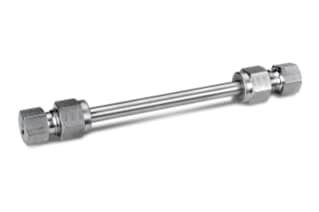
|
Chemistry |
C18 |
|
Separation Mode |
Reversed Phase |
|
Particle Substrate |
Silica |
|
pH Range Min |
2 pH |
|
pH Range Max |
8 pH |
|
Maximum Pressure |
6000 psi (415 Bar) |
|
Endcapped |
Yes |
|
Bonding Technology |
ODS2 |
|
Silanol Activity |
High |
|
Particle Shape |
Spherical |
|
Particle Size |
5 µm |
|
Endfitting Type |
Parker-style |
|
Pore Size |
80 Å |
|
Format |
Column |
|
Surface Area |
220 |
|
System |
HPLC |
|
USP Classification |
L1 |
|
Inner Diameter |
4.6 mm |
|
Length |
125 mm |
|
Carbon Load |
12 % |
|
UNSPSC |
41115709 |
|
Brand |
Spherisorb |
|
Product Type |
Columns |
|
Units per Package |
1 pk |

Spherisorb ODS2 Column, 80Å, 5 µm, 4.6 mm X 125 mm, 1/pk
Spherisorb ODS2 columns are reversed-phase C18 columns that are made of silica. With a carbon load of 11.5 percent, the ODS2 packing has an intermediate ligand density. The Spherisorb ODS2 Columns were meticulously engineered to be multi-purpose, silica-based, long-lasting, and extremely high-efficiency chromatographic columns. The column packaging procedures utilized in its construction assure that the lab equipment will always provide maximum performance and reliable results with every use. Any effects and process parameters such as packaging pressure time, temperature, flow rate, slurry volume, or even slurry solvent choice are addressed by the Spherisorb ODS2 Columns. This ensures that you always receive the best column stability and efficiency, as well as the best symmetry.
Spherisorb ODS2 Columns are made in dedicated and tightly managed Waters chromatography chemistry plants to assure the strictest cGMP and ISO 9002 compliance. As a result, you can count on the Spherisorb ODS2 Columns to deliver the most important performance characteristics, including peak symmetry, column longevity, column efficiency, and column-to-column reproducibility.
The Spherisorb ODS2 Column is a general-purpose, reversed-phase, silica-based C18 column with moderate ligand density packing and a predetermined carbon load of 12%. It can withstand a maximum pressure of 6000 psi (415 bar) and support a particle size of 5 m; however, it is always recommended to keep the pressure below the maximum allowable limit, as exposure to extremes of pressure, pH, or even temperatures will result in shorter column lifetimes and negatively impact performance. To meet the quality criteria necessary for liquid chromatography, use the Spherisorb ODS2 Column.
With the right lab equipment, you can boost your productivity. To discover more about the variations of the Spherisorb Columns or to find more products that work with it, browse through our website or refer to our catalog. You can shop for lab equipment directly from our website to ensure all your lab needs are covered as needed.
You may also be interested in Spherisorb ODS2 Guard Cartridge, 80Å, 5 µm, 4.6 mm X 10 mm, 3/pk, ideally suited to work with the general-purpose Spherisorb ODS2 Columns and increase their lifetime and performance.
What Is The Ideal Temperature For Spherisorb ODS2 Columns?
The Spherisorb ODS2 Column can be operated up to 45 degrees Celsius, but it is advised that it be run between 20 and 45 degrees Celsius to improve selectivity, minimize solvent viscosity, and boost mass transfer rates. It is crucial to realize that temperatures above ambient or close to/beyond the maximum limit can have a significant and detrimental impact on the column's lifetime, which can also be influenced by other parameters like pH and buffer conditions.